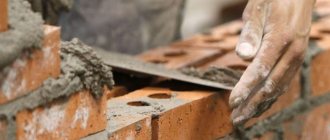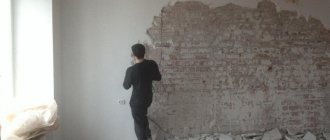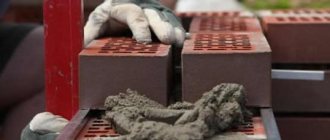- Before you begin restoration, assess the situation
- Superficial inspection
- Measurements
- Monitoring the development of deformities
- Composition analysis
- Preparing the wall before restoration
- Surface cleaning
- Treatment
- Padding
- Repairing minor damage
- Home coating and grouting
- Replacing individual bricks
- Aging brick
- Sealing cracks
- Injection (filling internal voids)
Before you begin restoration, assess the situation
What you will need: tape measure, small ruler, level, plumb line, feeler gauge.
Before starting work on the restoration of brickwork, it is necessary to assess its technical condition. The research can be divided into three stages.
Superficial inspection
Visual assessment allows you to detect:
- cracks on the surface of the brickwork,
- destruction (looseness, spalling, chips, potholes) and/or lack of individual bricks,
- weathering of seams,
- separation of masonry rows,
- rust spots and efflorescence on the surface,
- fungus, mold, moss.
Rust on the surface of the masonry is a sign of loss of structural integrity due to corrosion of steel embedded parts or reinforcement.
Measurements
- thickness and depth of cracks,
- seam thickness,
- angles of deviation of the masonry from the vertical and horizontal in the plane of the wall (at the seams),
- angles of deviation of the masonry from the plane of the wall.
To clarify the data obtained during a visual inspection and assess the extent of damage, it is necessary to measure:
Before restoring the brickwork, it is necessary to eliminate the root causes of deformation, otherwise repeated destruction cannot be avoided.
Monitoring the development of deformities
If cracks appear in the masonry, it is necessary to monitor the dynamics of destruction. To do this you need:
- measure the initial width and depth of the crack, mark the measurement location by installing beacons (made of paper or plaster);
- monitor dynamics at regular intervals;
- eliminate the root cause of deformation, which most often consists of subsidence of the soil, foundation or part of the building;
- make sure that the condition of the cracks has stabilized.
Composition analysis
If there is efflorescence on the masonry, it is also recommended to conduct a laboratory study of its chemical composition. It allows you to find out the amount of sulfates, nitrates, salts and moisture contained in the masonry.
Material for analysis is taken from four points distant from each other.
Cases when masonry is considered emergency
- Bricks or masonry blocks overhang and threaten to fall.
- The masonry is deviated from the vertical by more than 1/200 of the wall height or 1/3 of the masonry thickness.
- The masonry bulges (sticks out from the plane of the wall) by more than 1/200 of the height of the deformed area or 1/3 of the thickness of the masonry.
- Cracks cross four or more courses of masonry.
- The damage to the masonry is more than 2 cm deep.
- Disorder or separation of masonry rows is observed.
Cleaning and preparing old brickwork
Brickwork, especially if it is old, should first be cleaned of old plaster and dirt. To do this, just spray a solution of vinegar with water or a solution of a small amount of washing powder with water and 30 gm of salt on the wall and wipe it with a cloth. If the dirt is strong, you can try to scrub it off with a stiff brush, but this should be done carefully and somewhere on the edge. Only after making sure that the brick does not begin to crumble do you move to the central sections of the wall.
Advice: caustic chemicals for cleaning brick walls should be used as carefully as possible and only in cases where it simply cannot be done otherwise.
If the contamination is severe or we are talking about a brick fireplace, you can use professional cleaning products, for example: Neomid 550, Tiprom OC, Antisolex. Remember that they should be diluted with water and applied only with rubber gloves, taking care to protect your eyes from caustic substances.
It is likely that old brick will require additional sanding. This can be done using a grinder, a drill with a special attachment, or a wooden block wrapped in sandpaper.
In rooms with high humidity, such as a bathroom or kitchen, brickwork requires particularly careful pre-treatment in order to prevent the appearance of fungus and mold on its surface.
Reminder: if the mortar between the bricks begins to crumble, it should definitely be renewed, especially when it comes to wet rooms.
To strengthen the mortar, the seams between the bricks are cleared (“opened”) of old mortar to a depth of about 2 cm, the surface is wiped with a damp cloth, and then filled with fresh mortar using a narrow spatula so that the surface is as smooth as possible. The process is labor-intensive, however, you only have to do it once.
After a couple of days, when the grout between the seams has dried, the brick wall can be treated with a finishing coat.
Preparing the wall before restoration
What you will need: chisel, hammer, hammer drill, spatula, wire brush, sandpaper or sanding machine, solution container, brush or spray bottle, gloves and a respirator.
Surface cleaning
It is necessary to remove the remains of plaster, cement and mortar protruding from the joints from the surface of the masonry. Two methods are used for this.
Mechanical cleaning
- Wet the surface to reduce dust formation.
- Carefully remove any remaining cement-containing mortar using a scraper and a hammer.
- Chip off large pieces of mortar with a chisel.
- Remove small dirt with sandpaper, a stiff brush or a grinder.
A wire brush can leave scratches on the brick. Decide whether this is appropriate in your case.
Dry cleaning
It is used to remove tightly ingrained soot and other organic contaminants. A special detergent (wash or paste) is used to dissolve the contaminants. Work must be carried out according to the instructions.
Chemical cleaning is not suitable for sand-lime bricks. The components contained in the solution corrode its surface.
Removing damaged elements
In parallel with cleaning the surface, it is necessary to completely remove all destroyed bricks, clean out the external seams and crumbling edges of cracks. For this, a chisel, a grinder and a hammer drill are used.
Treatment
- One-time treatment of “saline” areas with a special composition that removes efflorescence.
Washing off efflorescence does not prevent its reappearance. For further protection, treatment with a salt blocker and a hydrophobic composition is necessary.
- Biocidal (antimicrobial) treatment of facade surfaces in two layers with an interval of 10-20 minutes.
- Sanitizing treatment of external walls with a brush, foundation at the base with irrigation. Repeat twice with an interval of 2-3 days.
Padding
For priming, depending on the condition of the historical brick, deeply strengthening compounds (the so-called “stone strengtheners”) or compounds with slight penetration into the base (primers based on potassium silicates) are used. Restoration primer strengthens the surface of the brick, evens out absorbency, and increases adhesion to other materials . All this is a guarantee of the durability of the result of restoration work. Depending on the type, the primer is applied by brush or spray in two layers with an interval of 2-4 hours.
For brick surfaces, silicate primer PETROMIX PL-04 is best suited.
Repair of brick walls
Repair of brickwork is necessary if cracks appear on it, seams crumble, and the brick itself begins to hold poorly or deteriorate over time. Simply plastering the wall is not the solution, since you want to preserve the original appearance of the surface.
Preparatory work
Methods for eliminating defects depend on their type and degree of wear, but in any case, careful preparation of the surface for repair is first necessary.
You will have to do the following:
- Remove a layer of old paint or plaster, if any;
- Clean cracks and seams from mortar residues, dirt and dust using a stiff brush;
- Rinse the wall with clean water;
- Dry thoroughly.
The most difficult of the above is cleaning the walls from plaster, mortar protruding from the joints and adhered cement.
There are two ways to clean cement from a brick:
- Mechanical.
Before starting work, the surface is well moistened with water - this makes the solution easier to clean. Flat spots are cleaned off with a spatula or trowel. You can also use a metal brush, but it will scratch the surface, especially of sand-lime brick. Bulk pieces of cement are chipped using a chisel and hammer. To completely remove all dirt, use sandpaper or a sanding machine.
Restoration of old masonry
The most difficult question may be how to repair brickwork if the brick crumbles and does not hold well in place. A collapsing stone must be replaced, since moisture penetrates into the masonry through it, which will ultimately lead to larger-scale negative consequences.
Therefore, such bricks are removed from the wall, for which the seams around them are opened to the maximum depth using a chisel and hammer or perforator.
If necessary, neighboring stones are also removed. Those that have not been damaged should be tried not to be touched and left in place. After removing the defective elements, the surface is prepared for restoration, as described above.
Note. It is quite difficult to match new brick to old masonry in color and texture. You may have to artificially age it with your own hands. How this is done will be described a little later.
The whole process looks something like this:
After removing the brick, remove the remaining mortar and dust from the resulting niche. We wet the surface.
Lay the solution at the bottom of the niche in a layer of 1-1.2 cm.
We dip the brick in water, and apply mortar to all faces except the bottom and front.
Injection (filling internal voids)
Injection (injection) of masonry is the process of pumping a special compound under pressure into the brickwork to fill internal cracks and voids. This technology for restoring brickwork is suitable both for eliminating single cracks and for universally strengthening the structure of brick walls.
Injection process steps:
- hole formation,
- blowing and moistening holes,
- installation of packers,
- caulking the crack to prevent the solution from escaping,
- securing packers with quick-hardening mortar,
- pumping a solution prepared according to instructions through the tubes using a syringe (for small cracks) or a pump,
- removing the tubes and filling the holes with a solution.
Petromix products include an injection solution for strengthening masonry IM-01. It does not shrink, has high penetrating ability and fills even small voids.
Three ways to change the look of a brick wall
Brickwork can become the highlight of an interior if you work on it a little. Among the options for its transformation, the most popular are cladding, painting and artificial aging. The choice will depend on the initial quality of the surface and the style in which the entire room is decorated.
Cladding with brick panels
Often, even after professional repairs, an old wall looks unsightly, although there are no complaints about its strength. In the case when you don’t want to lose the texture, but you couldn’t bring the surface into decent shape, you can cover it with decorative panels that imitate masonry.
This can be base brick siding, panels made of polyvinyl chloride, MDF or gypsum, as well as clinker tiles or thin facing bricks. And thermal panels are perfect for finishing and insulating external walls.
The installation method for these materials is different:
- Wall panels are attached to the frame;
- The facing tiles are glued to the surface using glue.
Look at some examples of such materials and their applications:
Don't be afraid to experiment with materials, but always pay attention to their characteristics and application. For example, brick siding can be used for interior decoration. But gypsum tiles are not suitable for external cladding.
Painting
You can preserve the relief and transform the perception of space by painting the masonry. This technique is very common among designers, as it allows you to decorate a room in different styles depending on the chosen color and painting method.
But it should be remembered that subsequently it will be impossible to return the wall to its original appearance by getting rid of a layer of paint. Therefore, before making this decision, think carefully and look at examples of such interiors.
The choice of finishing composition is of great importance. When deciding how to paint sand-lime brick on the outside, pay attention to the following characteristics of the paint:
- Waterproof. It should protect the facade from precipitation and humid air.
- Vapor permeability. The wall must “breathe”, otherwise it will be damp, which will lead to mold.
- Resistant to fading due to UV rays.
- Resistance to alkaline environments, since masonry mortar containing alkalis can destroy the coating.
The requirements for interior paints are more relaxed, so the choice is almost unlimited. The only thing that may upset you is the high price. But if instead of silicone or latex coatings you choose acrylic or ordinary slaked lime, the result will be no worse.
Advice. Brick is very hygroscopic, so before painting the masonry must be treated with an acrylic-based penetrating primer. This will save on paint.
One more tip. You shouldn't paint new walls. You need to wait at least a year for the leaching process to complete and for the masonry to dry out and shrink. Before painting, the walls must be cleaned of dust, dirt, salt deposits and mold and dried.
Aging
Many interior solutions require turning new, smooth and even masonry into old, time-worn ones. As you know, breaking is not building, and the problem of how to age a brick wall is much easier to solve than the reverse.
To do this, use the following methods (all in bulk or selectively):
- Treating the surface with abrasives
- coarse sandpaper, a wire brush or even a sandblasting machine.
After this treatment, the walls will need additional protection. So that they do not collapse and can easily be cleaned, they are coated with a special oil or water-based varnish.
Tips for work
Here are some recommendations that will help you repair damaged sections of brick walls yourself:
- Identifying the cause of the damage.
- Monitoring the dynamics of crack growth and other deformations.
- Preparation.
- Restoring the integrity of the wall.
- Restoration.
As you can see, in practice it is not so difficult to independently repair damaged brickwork. The main thing is to establish and eliminate the cause of the damage, otherwise there will be no point in carrying out restoration measures.
What defects may occur in brick walls?
It is recommended to constantly monitor the brickwork: any changes in its condition can lead to premature destruction of the wall. To prevent this from happening, the masonry is inspected, identifying shortcomings.
The most common defects on brick walls are:
- cracks,
- destruction of seams,
- the appearance of holes,
- formation of an uneven surface,
- as well as dampening of some sections of the wall,
- their freezing,
- sagging and delamination of masonry rows.
Each defect is preceded by a cause that served as a catalyst for the problem.
Cracks
Compared to other types of materials used to construct walls, bricks are the most susceptible to defects.
For example, cracks are the most common problem in brickwork. When examining a building, they are very easy to notice - they thin the strength of the structure like a net.
Large cracks in load-bearing walls pose a threat to the complete collapse of the building. If the crack has a horizontal or vertical location and is located in the brickwork above the doorway, such placement indicates a strong decrease in the load-bearing capacity of the structure.
There are cracks:
- Deformation.
- Temperature.
- Constructive.
- Shrinkable.
They can have different directions, be curved, through or superficial. The crack may be stable or progressing. The depth ranges from 0.1 to 1 mm or more.
The main causes of cracks that appear in brickwork are overloading the walls - then the cracks will be vertical and closed. If the problem is in the middle part of the building and has a vertical direction, then the reason lies in the absence of expansion joints when the wall is long.
The cause of a vertical crack of a rectilinear nature, open along the entire length, will be poor ligation of the brick. Small cracks of shallow depth indicate physical wear and tear of the brickwork, and multidirectional cracks indicate mechanical impact on the wall.
Seam failure
The problem of joint destruction is understood as their delamination, crumbling or loss of individual pieces of grout.
There are several reasons for this:
- incorrectly prepared solution;
- violation of grouting technology;
- violation of the sequence of actions;
- application of the freshly prepared solution.
If the master has chosen the wrong consistency for the grout, it will not fill all the cracks between the bricks. A solution that is too thin will simply leak out of the joints, and a solution that is too thick will be impossible to rub into the cracks.
All this leads to the fact that after grouting, after some time, defects form . If you do not follow the technology for treating the seams before grouting, do not completely clean them of debris and dirt, and do not treat them with clean water, then the solution will lie unevenly, which will also lead to a problem.
Another violation is to fill the seams with the wrong tool. For thin seams between bricks, jointing is necessary - this can be done with an ordinary sharp knife.
It is allowed to use the prepared solution or grout only when it has stood for a while. You need to work quickly so that the solution itself does not harden on the spatula . If excess occurs, it is immediately removed from the brickwork.
The appearance of holes
Through cracks or holes in a brick wall pose the greatest danger to the reliability of the building structure. If a visual inspection reveals holes in the wall, then the cause is deformation of the foundation. In this case, the prerequisite for this was not the shrinkage of the entire structure, but the influence of natural elements or the fall of a tree.
The reasons for the formation of through-type holes in the wall are:
- No bandaging of seams when laying bricks.
- Lack of brickwork reinforcement.
- No concreting at corners.
- The occurrence of increased stress in the masonry.
If geological work was skipped before construction, this also affects the appearance of through holes in the brick wall. In this case, repairs are no longer an option: the building is often considered unsafe and sent for demolition.
If there are constant water supply or sewerage leaks, holes may also appear on the brick wall - because of this, the soil becomes wet and the foundation collapses. The building will require major renovation. This article will tell you how to repair a hole in a brick wall.
Uneven surface
The main reason for an uneven wall surface is uneven brickwork. This is due to several factors:
- gross violation of technological standards;
- poor quality building material;
- improper installation of thermal insulation;
- using hollow brick instead of solid brick;
- poorly mixed solution.
Uneven brickwork has an unattractive appearance and therefore requires repair. Often the solution is to use putty.
Injecting cracks and large cavities
If there are cavities or large cracks in the masonry and its urgent restoration is required, then injections are carried out with epoxy, polyurethane or mineral compounds. This method is one of the most effective of those used to repair brick walls. As a result, the masonry is impregnated with a special solution that does not allow moisture to pass through. The most suitable for this purpose are organosilicon mixtures: silosans, ethylsiloxanes, methylsiloxanes. White spirit or kerosene are used as solvents. It all depends on the condition of the masonry, humidity and load in the place where the crack formed. The crack must be plugged, packers inserted into it and injected under pressure. Injectable compounds are fluid rather than viscous and will easily penetrate even the smallest cracks. But there is always a danger of the mortar stratifying in the thickness of the wall, and then only the most liquid component will get into the depths of the masonry, and the base, whose task is to strengthen the masonry, will remain on top. To prevent this from happening, fine sand is added to the composition.











